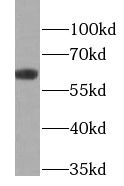Products
KRT6B antibody
Category:
Research Area:
| Synonyms: | CK 6B antibody, CK6B antibody, Cytokeratin 6B antibody, K6B antibody, keratin 6B antibody, KRT6B antibody, KRTL1 antibody, PC2 antibody, Type II keratin Kb10 antibody | ||
| Catalogue No.: | FNab04656 | Reactivity: | Human, Mouse |
| Host: | Rabbit | Tested Application: | ELISA, WB, IHC, IF |
| Clonality: | polyclonal | Isotype: | IgG |
- SPECIFICATIONS
- Product Name
- KRT6B antibody
- Catalogue No.
- FNab04656
- Size
- 100μg
- Form
- liquid
- Purification
- Immunogen affinity purified
- Purity
- ≥95% as determined by SDS-PAGE
- Clonality
- polyclonal
- Isotype
- IgG
- Storage
- PBS with 0.02% sodium azide and 50% glycerol pH 7.3, -20℃ for 12 months(Avoid repeated freeze / thaw cycles.)
Immunogen
- Immunogen
- keratin 6B
- Alternative Names
- CK 6B antibody, CK6B antibody, Cytokeratin 6B antibody, K6B antibody, keratin 6B antibody, KRT6B antibody, KRTL1 antibody, PC2 antibody, Type II keratin Kb10 antibody
- UniProt ID
- P04259
- Observed MW
- 60 kDa
Application
- Tested Applications
- ELISA, WB, IHC, IF
- Recommended dilution
- WB: 1:1000-1:5000; IHC: 1:50-1:500; IF: 1:200-1:1000
Validated Images
 mouse skin tissue were subjected to SDS PAGE followed by western blot with FNab04656(KRT6B antibody) at dilution of 1:1000
mouse skin tissue were subjected to SDS PAGE followed by western blot with FNab04656(KRT6B antibody) at dilution of 1:1000
 Immunohistochemistry of paraffin-embedded human lung cancer tissue slide using FNab04656(KRT6B Antibody) at dilution of 1:100
Immunohistochemistry of paraffin-embedded human lung cancer tissue slide using FNab04656(KRT6B Antibody) at dilution of 1:100
 Immunofluorescent analysis of U2OS? using FNab04656 (Cytokeratin 6B antibody) at dilution of 1:50 and Alexa Fluor 488-conjugated Goat Anti-Rabbit IgG(H+L)
Immunofluorescent analysis of U2OS? using FNab04656 (Cytokeratin 6B antibody) at dilution of 1:50 and Alexa Fluor 488-conjugated Goat Anti-Rabbit IgG(H+L)
- Background
- The protein encoded by this gene is a member of the keratin gene family. The type II cytokeratins consist of basic or neutral proteins which are arranged in pairs of heterotypic keratin chains coexpressed during differentiation of simple and stratified epithelial tissues. As many as six of this type II cytokeratin (KRT6) have been identified; the multiplicity of the genes is attributed to successive gene duplication events. The genes are expressed with family members KRT16 and/or KRT17 in the filiform papillae of the tongue, the stratified epithelial lining of oral mucosa and esophagus, the outer root sheath of hair follicles, and the glandular epithelia. Mutations in these genes have been associated with pachyonychia congenita.



